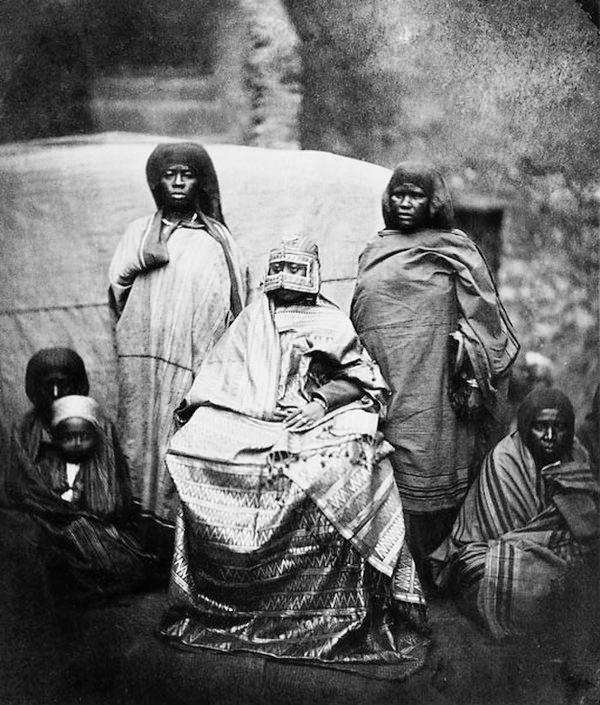
The Comoros Islands History: French Era (1841-1975)

Figure 1.--This is Jumbe-Souli, queen of the Comorian island of Mohéli, receiving a Franch delegation. The portrait was attributed to Désiré Charnay (1828–1915). Notice the woman holding a boy, presumably a young prince. The portrait was taken in 1863. We have not yet, however, been able to find infornariin about the queen. Notice that women of lesser rank did not have to cover their faces. It s not clear if the women are nobel ladies or slaves.
|
|
Only in the 19th century did European influence expand in East Africa, including the Comoros. Comoro rulers had security problems. There were Malagasy slsve raids. Sultan Alawi bin Husein requested French assistance against the Sultanate of Zanzibar which was threatening his domain (1816). This was just after the Napoleonic Wars. As France began to recover from the Napoleonic Wars, it began to build a new empire. This began in North Africa, but other territories were seized. Both France and Britain began to show an interest in the Comoros. William Sunley, a planter and British Consul was an important influence on Anjouan (1848–66), but it was the French who would prevail. The French purchased Mayotte (1841). Indepdent sultannates continued to control the other islands. Sultan Selim on Johanna island (Ndzuwani/Anjouan) seized the American whaler Maria, imprisoned her captain named Moores, and demanded a ransom (1850). Until this occurred the American whalers has been using Johanna island as a resupply port. We are not sure to what extent the U.S. Government was counsulted. There was, however, a small U.S. East Indian Squadron. There principal concern was Sumastran pirates and anti-slave trade patrols. The American anti-slave trade patrols were mostly off West Afria, but there were apparently vsome in the Induan Ocean as well. The East Indian Squadron staged the Johanna Expedition to free Cpt. Moores and rather than pay a ransom obtain compensation (February 1852). The Sultan refused until the sloop USS Dale bombarded the Sultan's harbor fortifications. This impressed Sultan Selim who paid US$1,000 and released Captain Moores. The Suez Canal was opened (1869). This greatly reduced the value of the Comoros economically as a supply port. They still were of some strategic importance. Sultan Said Ali bin Said Omar of Bambao, signed an agreement with the French government that accepted a protectorate over the entire island of Ngazidja (Grande Comore). The Sultanate of Bambao was a principality on the island of Grande Comore. Its capital was the town of Iconi. Sultan Said with French support united the sultanates of Grand Comore into the state of Ngazidja under his control. French protectorates were also established over Ndzwani (Anjouan), and Mwali (Mohéli). French Résidents (administrators) were posted on the three islands. The French left local control in the hands of the various sultans. The islands was recognized as within the French zone of influence by the Great Powers following the Berlin Conference which played an important role in the Scramble for Africa (1886-87). For several decades, the French ruled Mayotte which it had purchased separately. The French declared the three Comonro protectorates and Mayotte a single colony (1908). The Islands were attached to colonial Madagascar as a province (1912). After the German invasion and occupation of France during World War II (1940), the French colonial administration of Madagascar (including the Comoros) remained steadfastly loyal to Vichy France. The Brtish had to launch an expedition to seze the Islands (1942). They were returned to France after the War (1946). The Comoros were separated from Madagascar and became an overseas territory of France (1947). This gave them representation in the French National Assembly. As Madagscar moved toward independence, the Comoros chose to remain part of the French Republic (1958). Madagascar was given independence (1960). The Comoros were granted internal autonomy (1961). .
CIH

Navigate the Children in History Website:
[Return to the Main Comoros history page]
[Return to the Main Comoro page]
[About Us]
[Introduction]
[Biographies]
[Chronology]
[Climatology]
[Clothing]
[Disease and Health]
[Economics]
[Freedom]
[Geography]
[History]
[Human Nature]
[Ideology]
[Law]
[Nationalism]
[Presidents]
[Religion]
[Royalty]
[Science]
[Social Class]
[Bibliographies]
[Contributions]
[FAQs]
[Glossaries]
[Images]
[Links]
[Registration]
[Tools]
[Children in History Home]
Navigate the Boys' Historical Clothing national pages:
[Return to the Main African country history page]
[]
[Kenyan history ]
[Lessotho history ]
[Madagascar history ]
[Maldive history]
[Mauritius history]
[Mozambiaue history]
[Reunion history]
[Seychelles history]
[South Africa history]
[]
[Zanzibar history]
[Zimbabwe history ]
[France history]
Created: 7:53 PM 5/31/2018
Last updated: 7:53 PM 5/31/2018



